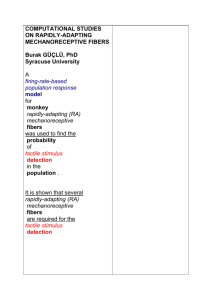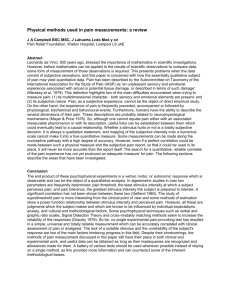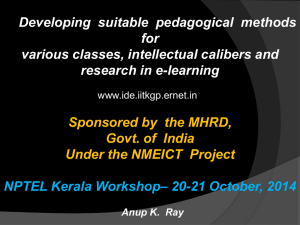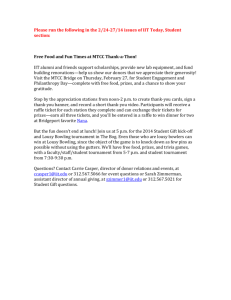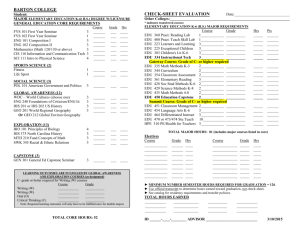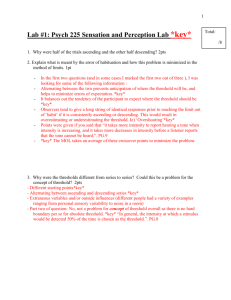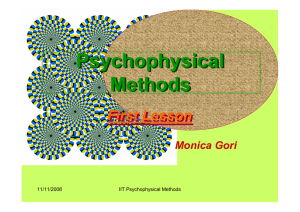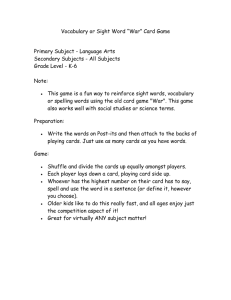Psychophysical Methods Psychophysical Methods
advertisement
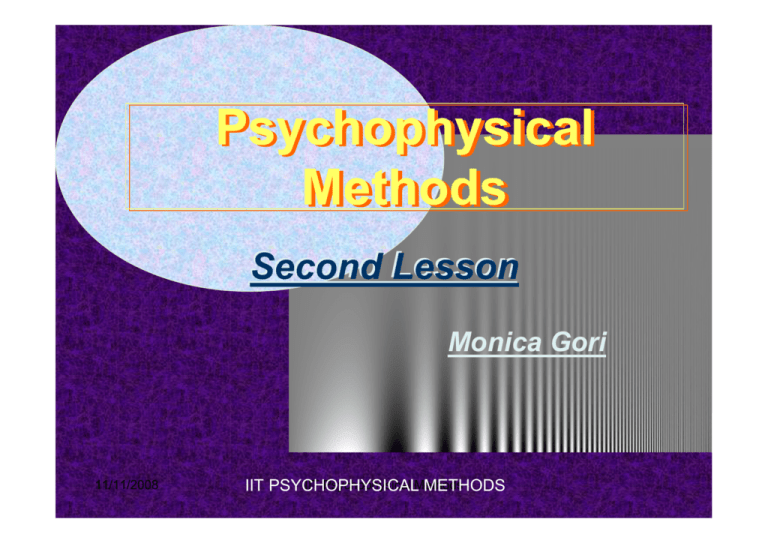
Psychophysical Methods Second Lesson Monica Gori 11/11/2008 IIT Psychophysical Methods IIT PSYCHOPHYSICAL METHODS Today Lesson’s Outline • Concept of absolute sensitivity • The absolute sensitivity of the Eye • The absolute sensitivity of the Ear • The absolute sensitivity for Touch • Principle of nomination • The classical psychophysical methods • Method of constant stimuli: Absolute Threshold -Methods of limits: absolute Threshold 11/11/2008 IIT Psychophysical Methods Absolute Threshold • The absolute threshold was defined as the smallest amount of stimulus energy necessary to produce a sensation. 11/11/2008 IIT Psychophysical Methods Absolute Threshold • Perceptual representation of a stimulus is not constant; it involves an additive random error. It follows that the psychometric function is not a step-function. Instead it is an S-shaped curve. • AT is defined as the 50thpercentilepoint 11/11/2008 IIT Psychophysical Methods Experiment Differential threshold • When a stimulus above absolute threshold is applied to the sense organ, the intensity of the stimulus must be increased or decreased by some critical amount before a person is able to report any change in sensation. 11/11/2008 IIT Psychophysical Methods Differential Threshold Difference threshold is the smallest difference between two stimuli that can be reliably detected 11/11/2008 IIT Psychophysical Methods Weber’s law • Below is a plot of some hypothetical data showing Weber's Law. The slope of the line is the Weber fraction. ∆Φ/ Φ =c For a fairly wide range of stimulus intensities 11/11/2008 IIT Psychophysical Methods Weber’s law • Whether the stimulus is applied to eye, skin, nose, tongue or other senses there is a lawful relationship between the size of the difference threshold and the stimulus intensity level. • valid for a wide range of stimulus intensities • it is good as a baseline to compare performance • not always true->increase greatly at extremely low stimulus intensities. 11/11/2008 IIT Psychophysical Methods Weber’s law Weber fraction for lifted weights. For 2 observers was nearly contact over the stimulus range, except for the lowest stimulus values (Engen 1971) 11/11/2008 IIT Psychophysical Methods Weber’s law • Weber fraction provide an index of sensory discrimination that can be compared over different conditions and different sensory modalities. • i.e. you can’t compare ∆Φ for vision in luminosity units with ∆Φ for audition in sound pressure units but you can compare the two modalities through the weber fraction comparison 11/11/2008 IIT Psychophysical Methods Temporal Frequencies Threshold (Hz) Weber’s law and dipper function A. Only vision B. Only tactile MG MG C. Bimodal Same Direction D. Bimodal Opposite Direction 3.3 c/deg cg3.3 10cg 10 c/deg MG 10 MG 5 c/deg 1 0,1 0,01 0,1 1 10 100 0,01 0,1 1 10 100 GM GM 0,01 0,1 1 10 100 0,01 0,1 1 10 100 1 10 100 GM GM 10 1 0,1 0,01 0,1 1 10 100 0,01 0,1 1 10 100 0,01 0,1 1 10 100 Pedestal Temporal frequencies (Hz) Pedestal Temporal frequencies (Hz) 11/11/2008 IIT Psychophysical Methods 0,01 0,1 Modification of Weber’s law • A modification of Weber’s law more closely corresponding to empirical data states: ∆Φ/(Φ+a)=c Where a is a constant that usually has a fairly small value 11/11/2008 IIT Psychophysical Methods Effect of an additive constant a • All the empirical value are often the same for all values of Φ when the correct value of a has been chosen. • ∆Φ/Φ constant but not for law levels Stimulus Intensity 11/11/2008 IIT Psychophysical Methods Effect of an additive constant a • ∆Φ/(Φ+a) plotted as a fx of Φ+a all the values of Φ are well described by the Weber’s law 11/11/2008 IIT Psychophysical Methods The significance of the constant • The constant a must be related to the operation of sensory system near threshold. • The exact significance of a has not been determined but maybe represent the amount of sensory noise that is present in the system when the value of Φ is 0. Since sensory noise is a spontaneous activity that exist as a background to stimulus in the nervous system its level may greatly influence the value of ∆Φ for very low intensity value. 11/11/2008 IIT Psychophysical Methods Absolute vs. difference thresholds • The interpretation of the constant “a” is that the concept of sensory noise provide a principle for understanding absolute and difference thresholds: ABSOLUTE THRESHOLD: value of Φ needed to increase the neural activity above the sensory noise level by some critical amount DIFFERENCE THRESHOLD: change in Φ needed to produce a critical difference in neural activity level associated with two intensity of stimulation 11/11/2008 IIT Psychophysical Methods Noise • Both absolute and difference thresholds involve the discrimination of differences in levels of neural activity. The noise can be originated from outside as well as from inside the observer. One source of external noise is uncontrolled fluctuation in the stimulus. • i.e. for sense of smell have illustrated a large effect that external noise can have in psychophysical experiments (∆Φ = form 25-35%) while the absolute threshold is the lowest measured for any sensory modality. • However if the noise was controlled was simple obtain a good Weber’s fraction-> this illustrate the importance of precise stimulus control in psychophysics. 11/11/2008 IIT Psychophysical Methods One other exception to the Weber's law • Another exception to the WL observed for discrimination for auditory and tactile vibratory discrimination ids the “near miss” where ∆Φ/ Φ first decrease rapidly as function of Φ but instead of becoming constant continues to decrease gradually 11/11/2008 IIT Psychophysical Methods Fechner’s psychophysics • Fechner’s work originating form an interest to establish a precise relationship between the physical event and mental reaction (1860 Elements of psychophysics). • He wanted to find a way to give to brightness loudness and painfulness (for example) a number that represent the experience. • As the stimulus intensity increase, it takes grater and grater changes in intensity change the sensation magnitude by some constant amount. 11/11/2008 IIT Psychophysical Methods Fechner ‘s law • Fechner proposed that sensation magnitude could be quantified indirectly by relating the value of ∆Φ on the physical scale to the corresponding values of jnd (just noticeable difference) stimulus dimension Φ in the sensation dimension (ψ) on the psychological scale Stimulus Intensity (Φ) Sensation Magnitude (ψ) 11/11/2008 IIT Psychophysical Methods Fechner ‘s law Jnd is interpreted as a standard units of sensation magnitude because it is the smallest detectable increment in a sensation and is therefore always psychologically the same size. He develop a scale of sensation magnitude starting from the absolute threshold. i.e. if ∆Φ/ Φ=1/5 Absolute Threshold=10 The first jnd=10*1/5+10=12 The second=12*1/5+12=14.4 By following this method you can create the stimulus intensity with the corresponding number of psychological units (number of jnd’s) 11/11/2008 IIT Psychophysical Methods Fechner ‘s law Ψ=k log Φ • • • Ψ= sensation magnitude K=constant multiplier that depends on the particular sensory modality and dimension Φ= intensity of the stimulus in units above absolute threshold • Fechner derived this general equation from the Weber’s law • To use this law we need to do two assumption: -the Weber law should be correct -the jnd should be an equal increment in sensation at all levels of stimulus intensity • However some experimental tests have shown that jnd’s are not always equal-> for this reason it is not considered an accurate statement of the relationship between stimulus intensity and sensation magnitude . 11/11/2008 IIT Psychophysical Methods Psychophysical measurement of threshold: absolute sensitivity • Measurement of absolute threshold has led to many significant advances in understanding sensory system. i.e. has facilitated our understanding of vision, audition, touch. 11/11/2008 IIT Psychophysical Methods The absolute sensitivity of the Eye • Light can be described as both a wave and a particle or quantum. We know that energy including light changes in discrete steps->the light quantum is the smallest possible unit of light energy. • It has been determined that vision occur when the number of quanta that are adsorbed by the retinal receptors exceeds some small critical number. • Eye respond to small amount of light energy and this amount has been found to depend on the condition of stimulation. 11/11/2008 IIT Psychophysical Methods 11/11/2008 IIT Psychophysical Methods Contrast Sensitivity 11/11/2008 IIT Psychophysical Methods The absolute sensitivity of the Eye • The functional relationship between the absolute threshold and the conditions that determine its value. • The absolute threshold depends up on previous stimulation exposing eye to intense light-> decreases the AT but it is recovered if the eye is subsequentially kept in darkness (after 1 hour it is completely recovered) 11/11/2008 IIT Psychophysical Methods The absolute sensitivity of the Eye • Dark adaptation curve-> by measuring AT periodically during recovery period and plot its value as a function of time in the dark. AT-> begin 100,000 times as high as the threshold after complete dark adaptation. • A biphasic curve for dark adaptation is present if the logarithm of the threshold intensity is plotted against the time in the dark. • In fact the dark adaptation curve by stimulating a region of the retina containing rods and cones was be found to be biphasic. 11/11/2008 IIT Psychophysical Methods Biphasic Curve for dark adaptation First phase= rapid stabilizing after 5-8 min rod-cone break = the point on the curve where the second phase begins is called rod-cone break Second phase= starting after about 10 minutes and decrease until after 40 min 11/11/2008 IIT Psychophysical Methods Biphasic Curve for dark adaptation • It is caused by the intersecting of rod and cone recovery curves that start at different intensity levels. The rod-cone break represent the point where rod sensitivity finally begins to exceed cone sensitivity and then the curve is determined by the continuing recovery of the rods. • It is possible also to measure the relative thresholds for detection of light as a function of wavelength and location of the stimulus on the retina. 11/11/2008 IIT Psychophysical Methods Stimulus eccentricity • Absolute threshold change also for different stimulus eccentricity (fovea-periphery) -> subj. detect a stimulus of 1º in the fovea and 8 º above the fovea The periphery of the retina is most sensitive to light with a wavelength of approximately 500 nm and the fovea when the stimulus wavelength is about 560 nm. Operation of rods needs much less energy than operation of cones 11/11/2008 IIT Psychophysical Methods Stimulus eccentricity • By increasing the intensity of a coloured light in a extrafoveal region of the retina containing both rods and cones when the rod threshold is reached the light appears uncoloured however with continued increases in intensity, we arrive to cone threshold and the colour is finally perceived. • Difference between the rod and cone thresholds measured in this way is called photocromatic interval-> interval of the stimulus intensity scale in which a coloured light is perceived as colour less and it vary with wavelength. 11/11/2008 IIT Psychophysical Methods What is the utility of the color perception? 11/11/2008 IIT Psychophysical Methods Perception of wavelengths • Eye perceive wavelengths from 400 to 750 nm but it is not equally sensitive to light of all wavelengths. 11/11/2008 IIT Psychophysical Methods Receptive fields in the retina 11/11/2008 IIT Psychophysical Methods The complementary colours 11/11/2008 IIT Psychophysical Methods The complementary colours 11/11/2008 IIT Psychophysical Methods Spatial summation • Receptors are able to summate energy over space within certain spatial limits • The total number of quanta is constant at threshold whether they are distributed sparsely over a large area (up to about 10 min of arc) or concentrated in a small area. 11/11/2008 IIT Psychophysical Methods Temporal summation • Visual receptors are able to summate energy over time up to about 1 sec • The total number of quanta of threshold is the same when exposing the eye to a weak stimulus for a long time as when exposing it to a strong stimulus for a short time 11/11/2008 IIT Psychophysical Methods Limits of the visual system From the previous observation we can understand the limits of the visual system to summate energy and we can use these limits in order to provide optimal conditions for next experiments. • • • • Retina dark adapted for 30 min Stimulus 20º from the fovea (maximum concentration of rods) Small field (10 min in diameter) to obtain optimal spatial summation Time exposure (0.001 sec) in order to have a good temporal summation • Light of 510 nm to have a optimal scotopic sensitivity to light of this wavelength 11/11/2008 IIT Psychophysical Methods Limits of seeing • Hecht et al by using these parameters found that in order to see it is necessary for only a quantum of light to be adsorbed by a single molecule of photochemical pigment in each of 5 to 14 rods-> a single quantum absorbed by a single rod is not sufficient because there is internal noise • In every moment rods without light, spontaneously send neural signals to the brain and the system is able to discriminate a signal form that noise only when it is bigger than a certain amount, we will understand better the concept of internal noise with the signal detection theory. 11/11/2008 IIT Psychophysical Methods The absolute sensitivity of the Ear • One way to measure auditory sensitivity to determine the smallest amplitude of a tone the remarkable. • Sensitivity of the eye under optimal conditions of stimulation has been found to be nearly matched by that of the ear. •Yung people can hear sound when its frequency of vibration is between 20 and 20.000 Hz but the auditory system is most sensitive to vibration between 2000 and 4000 Hz. These low psychophysical thresholds for detecting of sound suggest that, as in vision, the sensitivity of auditory system may be approaching a limit imposed by the nature of the stimulus. 11/11/2008 IIT Psychophysical Methods The absolute sensitivity for touch • One way of measuring tactile sensitivity is to determine the smallest amplitude of vibration of the skin that can be detected by an observer. Vibrotactile thresholds depend on stimulus factors as the locus of stimulation 11/11/2008 IIT Psychophysical Methods The absolute sensitivity for touch • Tactile thresholds for different stimulation areas -> when the stimulus was bigger than 0.02 cm2 the function have a U shape with the minimum around 250 Hz. Absolute tactile threshold depends on size of contact, frequency of vibration, position of skin stimulated. • The best detection threshold value for touch is lower with respect to that for audition suggesting the superiority of auditory system for this kind of detection. 11/11/2008 IIT Psychophysical Methods Verrillo’s experiments • By measuring vibrotactile thresholds Verrillo found that skin contains at least 2 receptor systems for detection of mechanical disturbances. One that summate energy over space for smallest stimulation and the second not capable of spatial summation for very small contacts. • He identified Pacini corpuscle (1966). 11/11/2008 IIT Psychophysical Methods Ongoing experiment • Open a power point presentation and create a grey rectangle, decrease the level of luminance in order to find the absolute threshold. 11/11/2008 IIT Psychophysical Methods Ongoing experiment • Then create two rectangle one dark grey (154) and the other light grey (100), with mean 127 and measure the contrast threshold by varying symmetrically the contrast of the two the threshold. After calculate the Michelson contrast with: with Imax and Imin representing the highest and lowest luminance 11/11/2008 IIT Psychophysical Methods Descriptive psychophysics Psychophysic is divided in: • Descriptive psychophysics= since the visual threshold changes as the wavelength of light changes for stimuli presented to the fovea or to the periphery of the retina. • We can use psychophysical measurement to define the sensitivity of a sensory system under particular conditions by changing different parameters as peripheral and central field, duration of dark adaptation, spatial and temporal summation->it is important to design a new experiment and to create specific system for people with particular deficits. 11/11/2008 IIT Psychophysical Methods Analytical psychophysics • The second function of psychophysics has been the testing of hypothesis about the nature of biological mechanisms underling sensory experience. • BASIC ASSUMPTION-> there is a basic correspondence between neural activity and perception 11/11/2008 IIT Psychophysical Methods Principle of nomination • It say that identical neural events give rise to identical psychological events. • When stimulus A and B produce the same neural response, they will yield the same sensory experience. The reflexive form of the principle states that when A and B produce the same sensory experience, they produce the same neural response. • This principle with the psychophysical procedures constitutes a powerful tool for discovering the neural events that determine sensory experience 11/11/2008 IIT Psychophysical Methods Principle of nomination • By assuming the reflexive Principle of Nomination is it possible to bridge a the gap between psychophysical and biological facts. • Since sensation are based on identical physiological reactions, a physiological hypothesis can be tested by a psychological procedure. 11/11/2008 IIT Psychophysical Methods Methods of response invariance • The response changes as the stimulus is varied • But the combination of stimulus variables generate identical response • For this reason we should be able to measure the action spectrum of rods with psychophysical technique and we should be able to compare it with that obtained through electrophysiology. 11/11/2008 IIT Psychophysical Methods Hypothetical set of results • Action spectra have the same form when measured psychophysically, photochemically and electrophysiologically 11/11/2008 IIT Psychophysical Methods Types of psychophysical observation • Class A: two stimuli of the same type are adjusted to produce identical sensations (i.e. matching experiment) i.e. adjust the intensity of two lights in order to have the same final percept. • Class B: any observation that cannot be expressed as the identity or non-identity of two sensation (with two stimuli different for some dimensions) (i.e. say when a green and a blue square appear of equal brightness)-> here you can’t apply the principle of nomination 11/11/2008 IIT Psychophysical Methods Psychophysical linking hypothesis • Class A assume that identical sensation are based on identical physiological events and there are many evidences that sustain this assumption by comparing psychophysical and neural threshold functions. 11/11/2008 IIT Psychophysical Methods The classical psychophysical methods • Methods for measuring thresholds: basic procedure • Biological system is variable in reaction and if I present the same stimulus the subject can respond to perceive it some trials but not other trials. • The threshold can’t be defined as a unique stimulus value. • To quantify the sensitivity of the sensory system since reaction to stimuli are variable the threshold must be specified as statistical value (i.e. 75%) 11/11/2008 IIT Psychophysical Methods Psychophysical Measurements • Psychophysical methods and procedures are useful in determining threshold, including visual field analysis. • For a perfect observer, threshold is the point where the stimulus can just be detected or where you just cannot detect the stimulus. Humans are not perfect observers, and often thresholds are defined in probabilistic terms: for example, half the points presented would be detected and half would not. • Threshold variability most likely depends on neural noise. • Measurement of visual response can be achieved through several methods. 11/11/2008 IIT Psychophysical Methods Methods of threshold measurement • Fechner developed 3 methods of threshold measurement: -Method of constant stimuli • Absolute Threshold • Difference Threshold -Methods of limits -Methods of adjustment These consist of experimental procedure and mathematical treatment of data used to measure absolute and difference thresholds. -Staircase (modified Method of limits) 11/11/2008 IIT Psychophysical Methods Methods of Constant Stimuli: Absolute Threshold • The method of constant stimuli is the procedure of repeatedly using the same set of stimuli (usually between 5 and 9) throughout the experiment. • • • • The 50% range is located within this range The lower end->should be a stimulus that is never detect The upper end should be always detect As the intensity level is increased within this range, the likelihood of detecting the stimulus will systematically increase in this way the percentage of detections as a function of stimulus intensity and Φ is determined. 11/11/2008 IIT Psychophysical Methods How can we construct an experiment with this method? • Preliminary observation should be done in order to locate the approximate range of values in which the stimulus of lowest intensity is seldom perceived and the stimulus of highest intensity is almost always perceived. 11/11/2008 IIT Psychophysical Methods How can we construct an experiment with this method? • The procedure requires that each stimulus be presented repeatedly, usually 100 times or more in a random order. • During the experiment a count of the number of yes or no response for each stimulus intensity level is kept. • For each stimulus the proportion (p) of yes responses is then computed and a graph called psychometric function is constructed. 11/11/2008 IIT Psychophysical Methods Psychometric function and the absolute threshold Proportion of “yes” responses • Stimulus intensity is plotted on the abscissa and the proportion of yes responses is plotted on the ordinate • The absolute threshold is defined as the stimulus intensity for which the proportion of trials resulting in yes response is .5 Stimulus Intensity 11/11/2008 IIT Psychophysical Methods Psychometric function and the absolute threshold Proportion of “yes” responses • In this case the 0.5 does not correspond to any of the stimuli used and the curve must be fitted and the threshold estimated • An ogive curve has been fitted to the points and the stimulus intensity for the 0.5 point can be estimated (as 12.3 units). Stimulus Intensity 11/11/2008 IIT Psychophysical Methods Psychometric function and the absolute threshold • In fact variation of biological and psychological measurement tends to be normally distributed when the frequencies of proportions of measurements of various magnitudes are plotted against the dimension on which variation is occurring the result is usually the bell-shaped normal distribution curve. • The best fitting curve of the data points is a S-Saped function-> the psychometric function often follow the ogive shape. 11/11/2008 IIT Psychophysical Methods Psychometric function and the absolute threshold • The ogive curve is a cumulative form of this distribution and how the proportion of case below a point on the normal distribution increases as the magnitude of the measurement increases. • The psychometric function can be determined by determining the best fitting through a mathematical technique (i.e. the method of least squares). The resulting estimation describe the values that minimizes the squared deviations of the empirical values from the function. Example absolute threshold and method of constant stimuli 11/11/2008 IIT Psychophysical Methods Yes-No procedure • The YES-NO PROCEDURE involves the subject judging the presence or absence of the signal. A stimulus is presented, during which the subject has to make a yes or no response. Correct response can range from 0% to 100% 11/11/2008 IIT Psychophysical Methods Yes-No procedure • With this procedure the subjects are given a long series of trials, usually more than 300 in a session in which they have to judge the presence or absence of a signal. 11/11/2008 IIT Psychophysical Methods Percentage of “yes” responses Psychometric function and the absolute threshold 255 250 245 Stimulus Intensity 11/11/2008 IIT Psychophysical Methods 240 Ongoing experiment 255 254 253 252 251 250 247 246 245 244 243 242 248 249 241 240 X for “yes” response o for “no” response 255 11/11/2008 254 253 252 251 250 249 248 247 246 IIT Psychophysical Methods 245 244 243 242 241 240
